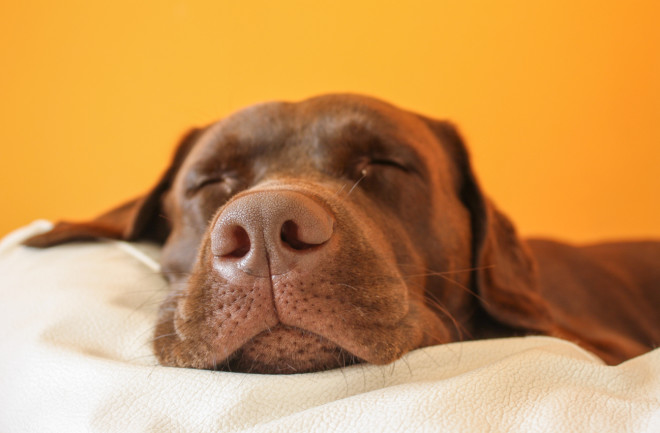Anyone with a dog probably takes for granted the existence of animal dreams. Watch your pup’s legs pound the air as they yip drowsily, and it’s hard to think of an explanation other than an imaginary mail vehicle chase.
To take a less commonplace example, an octopus named Costello was recently caught on camera during what appeared to be a nightmare. Apparently battling an invisible predator, the creature thrashed, shifted color and spewed a cloud of ink.
Do Animals Dream?
But how can we be sure these animals are really dreaming?
“Do they experience those penetrating nightly visions that humans do?” asks San Francisco State University philosopher David Peña-Guzmán in When Animals Dream: The Hidden World of Animal Consciousness. “Or do their minds simply plummet into a psychic void in which no conscious experience takes place?”
Unlike our fellow humans, non-human animals can’t tell us what goes on behind closed eyelids. And there’s simply no way to directly access another being’s mind (yet). Nevertheless, a wealth of tantalizing evidence makes it tempting to conclude we aren’t the only dreamers out there.
Read More: Uncovering the Mystery of Why Dogs Might Look Like Their Owners
The Role of REM Sleep in Animal Dreaming
In the late 19th century, Sigmund Freud framed dreams as the fictional fulfillment of repressed desires, igniting the scientific world’s interest in this mysterious and understudied phenomenon. Experts have clashed over how best to interpret dreams ever since, but the basic physiology is fairly well understood.
Most dreams — especially vivid ones — occur during REM sleep, a phase characterized by rapid eye movement and high brain activity. We lose almost all muscle tone during these cycles, resulting in a temporary paralysis known as atonia that prevents us from acting out our dreams and potentially hurting ourselves.
Among the first to notice this inhibition of motor function was a French neuroscientist named Michel Jouvet. In the late 1950s, he discovered that a brain structure called the pons was responsible for regulating atonia in cats.
When Jouvet surgically removed part of the pons, the sleeping felines behaved as they might have within their dreams: pouncing, scratching, hissing, and generally acting as if they were hunting or fending off an attacker.
Read More: Why Do We Dream? Science Offers a Few Possibilities
Mentophobia
Jouvet’s work offered the first compelling evidence of nocturnal visions in other species. But, as Peña-Guzmán notes, scientists have historically been reluctant to describe the nighttime behavior of animals in humanlike terms.
Until recently, in fact, the very word “dream” was scarce in animal sleep literature. By Peña-Guzmán’s estimation, its first explicit use in a scientific journal came only in 2020, when biologists Paul Manger and Jerome Siegel published their article, “Do All Mammals Dream?”
Plenty of researchers, from Jouvet’s day to the present, object to anthropomorphism. Instead, they adhere to the rule of thumb that activity in animals should never be attributed to high-level psychological processes when some simpler (and evolutionarily older) process can explain it.
The zoologist Donald Griffin dubbed this idea mentophobia, a strong resistance to the idea that animals are conscious and have minds that in some meaningful way resemble our own.
“Once animals are pigeonholed into this category, their fate is sealed,” Peña-Guzmán writes. “There are simply too many things one cannot expect from a thoughtless brute. One of them is the capacity to dream.”
Read More: Do Insects Have Feelings and Consciousness?
Do Animals Have Consciousness?
Yet more and more research has lent support to the possibility of animal consciousness. Some of the most intriguing studies reveal specific neural correlates of dreaming — mental states that are associated with human dreams and may correspond to animal dreams as well.
Researchers have found that, for some non-human species, brain activity while in REM sleep perfectly matches brain activity while awake. This suggests that the animals might be replaying daytime events as dreams.
For example, zebra finches show a precise pattern of neural activation when they rehearse their song during the day, and an identical pattern during sleep. In the same vein, the neurons that fire when a rat navigates a maze fire again as it sleeps, in the same order.
Could it be retracing its steps in a dream labyrinth?
Well, one theory for the purpose of dreams is that they help the brain process new information, build memory and reinforce learning. In humans, dreams consolidate our waking experience — transforming it from a disjointed stream of occurrences into something useful.
From this perspective, it’s easy to see how running through simulations of a bird singing its song or a rat navigating a maze could aid these creatures’ memory and learning.
Read More: Do Animals Fall in Love?
What Do Animals Dream About?
Of course, that doesn’t prove that animals have subjective dreams like ours, in which we are actively aware of whatever we envision. It could be that these brain processes happen without the animal experiencing anything life-like in their dreamscape.
Some researchers have called this an “algorithmic implementation,” sort of like a laptop running a program unconsciously.
After all, our only conclusive knowledge of human dreams comes from verbal reports; while you can use language to share tales from the obscure realm of slumbering, animals cannot.
Yet, elusive as it may be, definite proof of animal dreams would suggest that some of our evolutionary cousins have a depth of inner experience we typically reserve for Homo sapiens alone — and an experience entirely distinct from the only one we know.
In Peña-Guzmán’s words, it would be “an irrefutable sign that there exist, alongside ours, endless other worlds — utterly ‘Other,’ inhuman worlds. Enigmatic, foreign, hidden animal worlds.”
Read More: Can Animals Get Schizophrenia, or Is It Unique to Humans?




